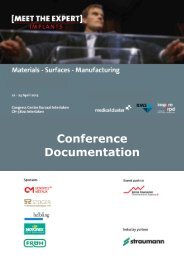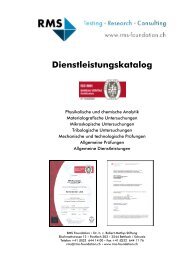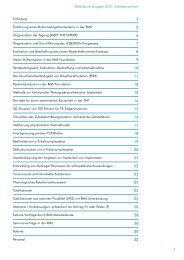RMS-Bericht 2012 - RMS Foundation
RMS-Bericht 2012 - RMS Foundation
RMS-Bericht 2012 - RMS Foundation
You also want an ePaper? Increase the reach of your titles
YUMPU automatically turns print PDFs into web optimized ePapers that Google loves.
Das menschliche Skelettsystem erleidet im<br />
Laufe des Lebens immer wieder diverse Verletzungen.<br />
Während viele dieser Verletzungen<br />
vom Körper selbst geheilt werden können,<br />
bedürfen andere einer medizinischen Behandlung.<br />
Eine Herausforderung sind trotz<br />
intensiver Forschung bis heute Verletzungen<br />
des Gelenkknorpels. Beschädigtes Knorpelgewebe<br />
tendiert dazu, im Laufe der Zeit immer<br />
mehr zu degenerieren. Bei betroffenen Patienten<br />
besteht daher eine erhöhte Gefahr der<br />
Osteoarthritis, die einen totalen Gelenkersatz<br />
nötig machen kann.<br />
Idealerweise könnte ein solcher Eingriff durch<br />
Verhinderung des Knorpelabbaus vermieden<br />
werden. In der <strong>RMS</strong> wird ein neues Implantat<br />
entwickelt, welches diese Funktion indirekt<br />
durch einen Dämpfungseffekt übernehmen<br />
könnte und mechanische Last ähnlich einem<br />
Knorpel oder Meniskus absorbiert und verteilt.<br />
Potenzielle Materialien hierfür sind Hydrogel-<br />
Polymere. Die entwickelten Materialien können<br />
wie der Knorpel grosse Mengen an Wasser<br />
absorbieren. Ihre mechanischen Eigenschaften<br />
können durch Änderung der molekularen<br />
Bestandteile gezielt variiert werden; dies ermöglicht<br />
einen Gradienten der mechanischen<br />
Eigenschaften im Implantat, das dadurch ein<br />
verbessertes Aufprallabsorptionsverhalten<br />
aufweisen soll.<br />
Eine wichtige Eigenschaft bei der Entwicklung<br />
dieses Materials ist das tribologische Verhalten<br />
gegenüber Knorpel. Die von uns entwickelten<br />
Materialien weisen um ein vielfaches kleinere<br />
Reibungskoeffizienten auf als andere in der<br />
Orthopädie etablierten Materialien (Abbildung).<br />
Implantate aus diesem Material besitzen das<br />
Potenzial, als innovative Lösung beschädigtes<br />
natives Knorpelmaterial im Patienten für<br />
mehrere Jahre zu schützen – vorausgesetzt,<br />
die für <strong>2012</strong> geplanten Ermüdungstests des<br />
Implantats werden erfolgreich absolviert.<br />
<strong>RMS</strong> Report edition <strong>2012</strong> – Chemistry & Biology<br />
Potenzielle Anwendungen von pHEMA-Hydrogelen in der Orthopädie<br />
Potential pHEMA hydrogel application in orthopedics<br />
Our skeletal system is exposed to many injuries<br />
with different degrees of severity during<br />
lifetime. Many of these injuries are repaired by<br />
the body itself, while others require medical intervention.<br />
Despite intense research, there are<br />
still injuries, which cannot successfully heal, i.e.<br />
injuries of the articular cartilage. Injured cartilage<br />
tends to degenerate over time. Patients<br />
suffering from this condition are more likely<br />
to develop osteoarthritis, being candidates for<br />
total joint replacement procedures.<br />
Ideally, such procedures could be delayed if<br />
the degeneration of the cartilage is avoided.<br />
At the <strong>RMS</strong>, we are developing a new implant<br />
that could fulfill such a function through a<br />
cushioning effect. This implant might be able<br />
to achieve an analogous function in the body<br />
to the cartilage and the meniscus, absorbing<br />
and uniformly distributing the mechanical<br />
load in the articulation. As potential implant<br />
materials we have chosen hydrogel polymers.<br />
The hydrogels under development can absorb<br />
a high amount of water, similar to cartilage<br />
tissue, and their mechanical properties can be<br />
tuned by varying their molecular components.<br />
This is of vital importance,<br />
because the<br />
implant is intended<br />
to posses a gradient<br />
of mechanical properties<br />
across its body<br />
in order to increase<br />
its shock absorption<br />
performance.<br />
An important feature<br />
of the material is its<br />
tribological behavior<br />
when articulating<br />
versus cartilage. The<br />
new material blends<br />
show friction coefficient<br />
values that are<br />
several times lower than already established<br />
materials used in the orthopedic field (figure).<br />
Implant design optimization and fatigue tests<br />
on the new implant are planned to begin in<br />
<strong>2012</strong>. If these tests are successful, this implant<br />
might represent an innovative solution to<br />
protect a damaged native cartilage tissue in<br />
patients for several years.<br />
J. Sague<br />
B. Andreatta<br />
C. Wälti<br />
Y. Loosli<br />
C. May<br />
R. Luginbühl<br />
in collaboration with<br />
J. Vogt, PolyPhysConsult,<br />
Flüh<br />
Abbildung:<br />
Reibungskoeffizienten von<br />
pHEMA-basierten Hydrogelen,<br />
UHMWPE und CoCrMo<br />
gegen Knorpel (Ergebnisse<br />
einer in vitro Studie der<br />
<strong>RMS</strong>).<br />
Figure:<br />
Friction coefficient values of<br />
pHEMA based hydrogels,<br />
UHMWPE and CoCrMo alloy<br />
versus cartilage (results<br />
from an in vitro study performed<br />
at <strong>RMS</strong>).<br />
21





